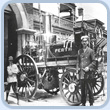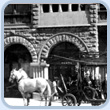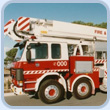
The history of Western Australia’s (WA) emergency services is linked closely with the origin and development of the Swan River Colony from the mid 1800s. From these early times authorities were concerned about the welfare of its community members.
Records illustrate that structure fire and bushfire were a terrible risk to communities which could have devastating consequences. Without reliable access to water or a means to pump it effectively, firefighting during the 1800s and early 1900s was inadequate.
In the 1960s, the Civil Defence Service was created to help protect Australians from threats and disasters such as earthquakes, floods and nuclear war. Today it is known as the State Emergency Service (SES). The SES provides highly skilled volunteers who provide a critical community service.
DFES has a significant collection of fire service and civil defence SES materials which includes buildings, archives, photographs, equipment, uniforms and appliances (trucks). Considerable research was undertaken to develop their stories and history.
The collection of archives, photographs and uniforms is housed at the DFES Education and Heritage Centre (FEHC) while the collection of vintage fire appliances is housed at the DFES Training Academy in Forrestfield, WA.
DFES’s heritage began with the early fire service which provided response to most emergencies in the community, especially, fires, accidents and rescues. The Fire Services operated Perth’s ambulance service up until 1922.
To find out more about the DFES Heritage Collection and the history of emergency services, use the links below.
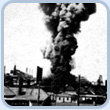
There were no fire brigades when the Swan River Colony was formed in Western Australia (WA) in 1829. For almost sixty years the growing settlements around WA had little means of controlling or extinguishing a fire. Response to public outcry would see a volunteer fire brigade formed. However, without training, a reliable water source or equipment little could be done to stop a fire.
Devastating fires continued to destroy life and property. In 1866 the premises of Solomon Cook, a well-known Perth engineer, was burnt to the ground. The local newspaper at the time reported:
"The fire raged for more than half an hour before the fire engine arrived: and when brought to ply, it fell far short of the efficient service expected. The result of this has been a very spirited movement for the organisation of a volunteer brigade."
In 1887, a man, who later became the first Chief Officer in Western Australia, stood amongst a crowd of onlookers as the Military Pensioners Barracks in Perth was severely damaged by fire. After witnessing its devastation and the poor response by the fire brigade and equipment James Lapsley joined the fire service and made it his life’s work to continually improve and expand its capabilities.
More information (PDF - 535 KB)
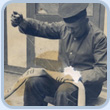
Horses to be fed…hoses to be mended…
At midnight on January 1,1901 the Perth Fire Brigade moved into the spacious new Perth Fire Station. Happy to leave the cramped Town Hall under-croft, the new facilities included three engine bays, stables, a dormitory, kitchen and workshops.
With limited permanent staff, unmarried men were required to live on station in the upstairs dormitory and married men could live close by. Their houses, fitted with a special alarm, could be no more than a two-minute bicycle ride away.
The Chief Officer and his family also lived on station. There was even a fire pole leading from the bedroom to the watchroom. After five years they moved to a house close by. The Deputy used the quarters until the mid 1920s. After that, senior officers used the rooms until the station closed in 1979.
Under the direction of Superintendent and engineer James Lapsley, The WA Fire Service and Perth Brigade were recognised as being professional and resourceful. Funding was always an issue however, as costs were spread across an expanding fire service in the city and country areas.
More information (PDF - 813 KB)
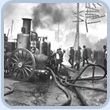
One of the biggest challenges faced by the WA Fire Service was water. It was critical to improve access and delivery of water by brigades at a fire scene.
Hand operated pumps were limited. They could not produce enough pressure for effective water delivery especially at a major fire.
It was not until the introduction of the steam engine in the late 1800s improvements occurred. The boiler on the horse-drawn steam pump could generate considerable pressure. This was achieved by keeping the water chamber just below boiling point while on station. A fire was then lit under the boiler before leaving to a fire call, which would boil on the way to a fire. There would then be enough steam to drive the piston and pump the water.
It would have been amazing to see horses at full gallop heading to a fire followed by a trail of steam. It would have also taken considerable skill to drive these horses through the bustling city, turn corners and give way to pedestrians. However, accidents did happen on occasion. In the WA Fire Brigades Board Minutes of 1899, it notes a collision between the Perth horse drawn steam pump and a baker’s cart. One of the brigade horses was killed.
More information (PDF - 1.1 MB)
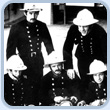
Smoke - A Fire Fighter’s Nemesis
Before the introduction of breathing protection, firefighters had little choice but to inhale smoke and toxic fumes when fighting fires. In some countries firefighters were known as “smoke-eaters”. With no face or lung protection, the heat and carbon released by burning materials would enter the lungs causing irritation, breathing difficulty and even burns to the lungs themselves.
The firefighters pictured entered a large fermentation tank at the Perth Swan Brewery in 1974 to rescue an injured and unconscious painting contractor. A buildup of paint fumes within the container ignited causing a large explosion seriously injuring the worker. This rescue would not have been possible if breathing apparatus was not available.
More information (PDF - 2.9 MB)
For over 110 years, the Western Australian (WA) Fire Service has utilised many types of appliances ranging from hand drawn hose reels and pumps, horse drawn steamers and crew carriers, to motorised light, medium and heavy pumpers, aerial platforms and ladders and specialist appliances.
WA received its first motorised appliance in 1910. It was a Dennis Light Pumper and crew carrier imported from England. This appliance was sent to Fremantle Station. Perth Fire Station received its first motorised appliance in 1911. This was a crew carrier but did not pump water.
More information (PDF -1.9 MB)
